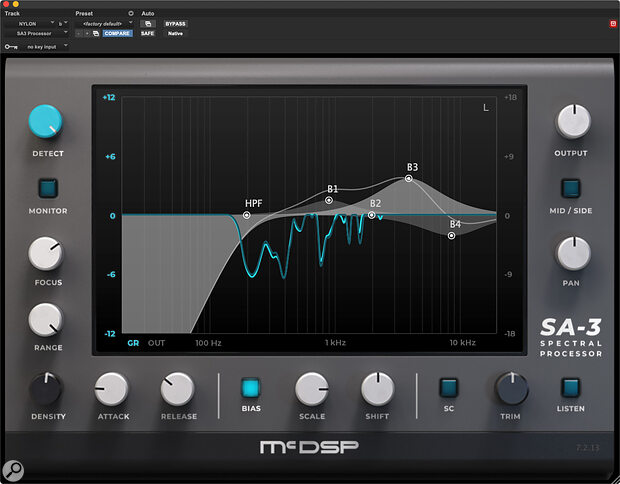The best plug‑ins make under‑the‑hood sophistication simple in practice...
Based on hardware developed by Hollywood re‑recording mixer Mike Minkler, McDSP’s SA‑2 is a multiband dynamics processor optimised for dialogue. Picking up where that plug‑in leaves off, the new SA‑3 is dubbed a Spectral Processor rather than a Dialog Processor. This doesn’t mean it’s ghostly, rather that its applications now go beyond improving the sound of the human voice.
Available in all major native formats on macOS and Windows, and authorised using iLok, SA‑3 eclipses its predecessor in terms of the granularity of its processing. Where SA‑2 offers five bands of dynamic control, SA‑3 is capable of working in over 1000. And as only a sadist would ask the end user to set parameters individually for this many bands, McDSP have developed a friendly, resizeable UI that allows you to direct proceedings with a few clicks.
Suppression Fire
In a nutshell, the SA‑3 algorithm identifies resonant frequencies and applies narrow‑band gain reduction to suppress them. The Detect knob acts like a global threshold control, and a good starting point is to turn this knob clockwise until you start to see gain reduction activity in the main graphical window. A Monitor button allows you to audition only what’s being taken away from the signal.
There are conventional Attack and Release controls, a Range setting that determines the maximum amount of gain reduction, plus controls labelled Focus and Density. The former “alters the spectral processing algorithm to only target more persistent resonant frequencies”, while the latter determines the extent to which the harmonic frequencies of a resonance should be suppressed as well as its fundamental.
By default, SA‑3 processing is applied across the entire spectrum, but the Bias button engages an EQ‑like interface that allows it to be weighted or targeted towards specific areas. This offers a high‑pass filter plus four flexible bands which can be given a parametric or shelving response. Applying an EQ ‘boost’ leads to more processing taking place in the designated part of the frequency spectrum, whilst cutting at a particular frequency makes it less likely that SA‑3 will do anything. The Scale and Shift controls dial in vertical and horizontal offsets for the entire Bias curve, which is quicker than trying to adjust all five bands at once.
Smooth Operator
There are conceptual similarities between SA‑3 and plug‑ins such as Oeksound’s Soothe 2 and Soundtheory’s Gulfoss, but in practice, it’s distinctly and usefully different from those products, and has its own strengths. Regardless of its rebranding as a general‑purpose ‘spectral processor’, SA‑3 still shines most of all on vocals. With an almost magical knack for zapping unwanted honks and exaggerated overtones, it tracks changing notes and timbres smoothly and effortlessly. Bump the high‑pass filter up to 4kHz or so and it becomes an absolutely superb de‑esser. Changing the Attack time can make quite a difference to the amount of processing that takes place, sometimes more so than adjustments to the Detect or Range controls, but I found that I generally got the most natural results by leaving it somewhere in the middle.
SA‑3 is pretty much the proverbial ‘make it sound better’ box...
As far as vocals are concerned, in fact, SA‑3 is pretty much the proverbial ‘make it sound better’ box. It doesn’t audibly compress voices; nor does it make obvious tonal changes unless pushed quite hard. It just makes it sound as though you’d done a better job of recording them in the first place. On other sources, it always keeps the Hippocratic oath, but depending on the instrument, it’s occasionally hard to get it to do enough. For example, even when I dialled in a huge Bias boost at 400Hz and cranked the Detect and Range controls, it was reluctant to get too involved with a ringy snare track. By contrast, it works brilliantly for invisibly polishing things like fingerstyle guitar; and on a DI’ed bass part where the fundamental is just a bit too heavy, SA‑3 will follow it up and down the fretboard to keep it locked down in a way that no conventional EQ or multiband compressor can.
There is clearly some very clever tech at work under SA‑3’s hood, but as ever, that’s only part of the story. What’s just as important is the way McDSP have developed a simple, intuitive front end to allow you to control that tech. It’s almost a challenge to get SA‑3 to do something that sounds obviously processed or unnatural. Most of the time you won’t know it’s doing anything at all — until you hit the bypass button.
Summary
With advanced multiband processing controlled by a few well‑chosen parameters, SA‑3 is an intuitive plug‑in that will polish your vocals up a treat.


